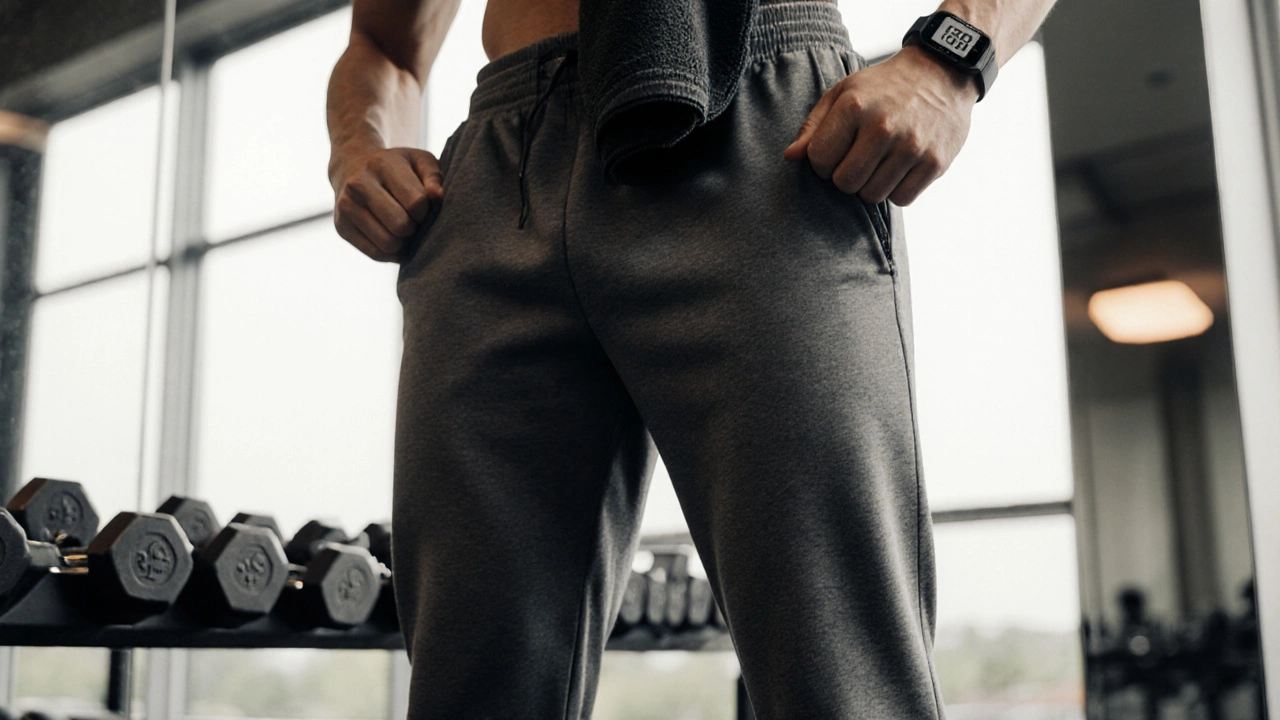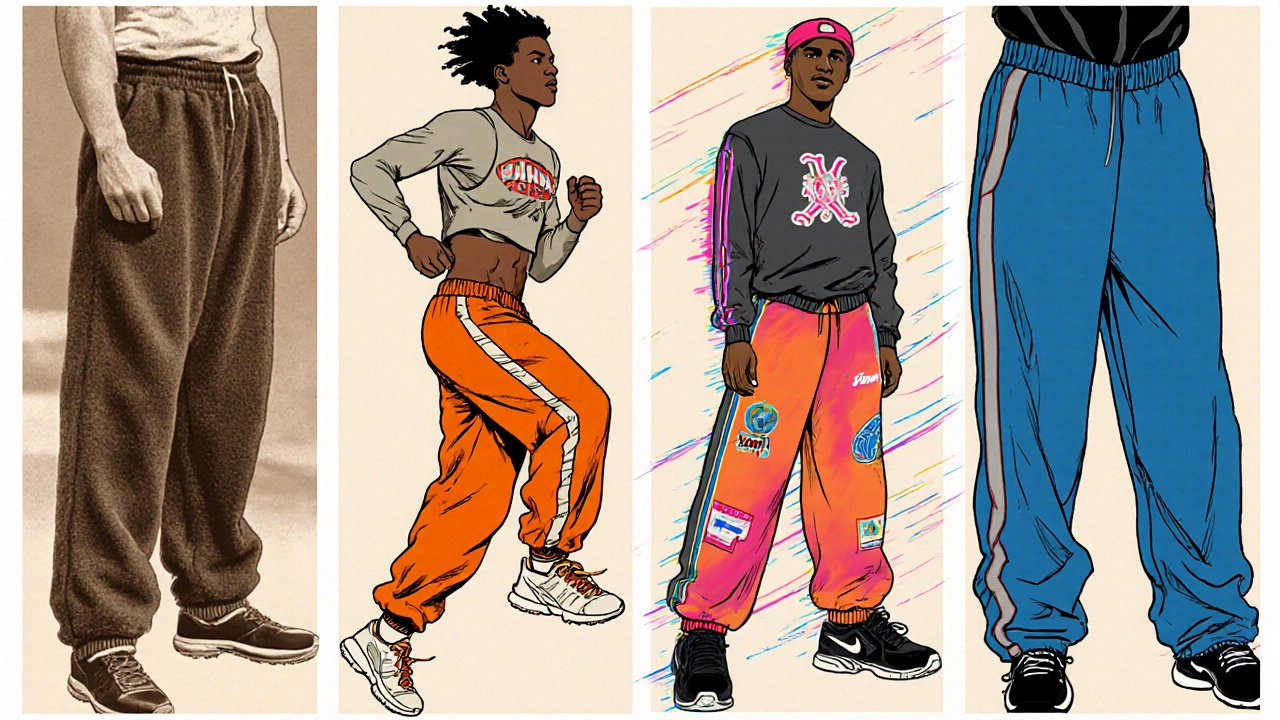Sweatpants & Sportswear: Are They the Same?

Sweatpants vs. Sportswear Classifier
Enter your sweatpants details and click "Classify My Sweatpants" to see if they qualify as sportswear.
Comparison Table
| Feature | Sweatpants | Joggers | Track Pants | Leggings |
|---|---|---|---|---|
| Typical Fabric | Cotton-poly blend, brushed fleece | Polyester-spandex, lightweight | Polyester mesh, sleek | Spandex-rich knit |
| Fit | Relaxed, tapered at ankle | Slim, tapered, elastic cuffs | Loose-fit, side stripes | Skin-tight |
| Performance Focus | Warmth + moderate moisture-wick | High-speed wicking, stretch | Breathability, speed | Compression, flexibility |
| Primary Use | Gym, casual wear, layering | Running, HIIT, streetwear | Track, sprinting, training | Yoga, pilates, layered looks |
When you pull on a pair of cozy sweatpants and head to the gym, are you technically wearing sportswear? The short answer is: mostly yes, but the story has a few twists. Let’s break down what counts as sportswear, why sweatpants often fit the bill, and when they cross into loungewear or street style.
What Counts as Sportswear?
Sportswear is a category of clothing designed for physical activity. It usually features performance fabrics (moisture‑wicking, stretch, quick‑dry), ergonomic cuts, and construction that supports movement. Think of items you’d buy for running, yoga, basketball, or a weekend hike.
Retailers also use the term to describe a lifestyle segment called athleisure. Athleisure blends performance tech with street‑ready aesthetics, letting you transition from the gym to a coffee shop without a change of clothes.
Sweatpants 101: Where Did They Come From?
Originally, sweatpants were born in the 1920s as part of athletic uniforms. They were made from heavy cotton‑rich loops called "French terry" that could absorb sweat - hence the name. Over the decades they evolved:
- 1970s: gym‑wear staple for runners and weightlifters.
- 1990s: street‑style icon, especially in hip‑hop culture.
- 2000s‑present: upgraded with polyester blends, elastic cuffs, and tapered silhouettes.
Today a typical pair of sweatpants includes performance fabrics like cotton‑polyester blends, brushed interior for softness, and an elastic waistband for comfort.

How Sweatpants Fit Into the Sportswear Family
Because sweatpants were created for athletes, they inherit many sportswear traits:
- Material: Modern sweatpants often use moisture‑wicking blends that pull sweat away from skin.
- Fit: The relaxed cut allows a full range of motion, whether you’re squatting or stretching.
- Function: Elastic cuffs keep fabric from riding up, and many have zip pockets for keys or a phone.
However, not every pair qualifies. Ultra‑soft fleece joggers meant for lounging lack the technical finish that a runner would need. That’s why you’ll see brands label some lines as "loungewear" and other lines as "training".
Quick Comparison: Sweatpants vs. Joggers vs. Track Pants vs. Leggings
| Feature | Sweatpants | Joggers | Track Pants | Leggings |
|---|---|---|---|---|
| Typical Fabric | Cotton‑poly blend, brushed fleece | Polyester‑spandex, lightweight | Polyester mesh, sleek | Spandex‑rich knit |
| Fit | Relaxed, tapered at ankle | Slim, tapered, elastic cuffs | Loose‑fit, side stripes | Skin‑tight |
| Performance Focus | Warmth + moderate moisture‑wick | High‑speed wicking, stretch | Breathability, speed | Compression, flexibility |
| Primary Use | Gym, casual wear, layering | Running, HIIT, streetwear | Track, sprinting, training | Yoga, pilates, layered looks |
Notice how each bottom leans toward a particular activity. If your sweatpants have technical finishes (moisture‑wicking, stretch), they comfortably sit in the sportswear zone. If they’re pure fleece, they’re more loungewear.
Styling Tips: When Sweatpants Are Sportswear, When They’re Not
Here’s a quick cheat sheet to decide if your sweatpants are ready for the workout floor or just a coffee run:
- Look at the material: If the label reads "moisture‑wicking" or "performance", treat them as sportswear.
- Check the cut: Tapered legs with elastic cuffs usually mean the design anticipates movement.
- Pair wisely: Match with a breathable tee or a technical hoodie. A silk shirt over fleece will feel off on a treadmill.
- Mind the occasion: For a formal office, opt for tailored joggers or a sleek track‑pant silhouette, not bulky fleece.
Brands like Nike and Adidas now market "training sweatpants" that sit squarely in the sportswear aisle, complete with zip pockets and reflective details.

Common Misconceptions and Pitfalls
Many people assume any relaxed‑fit pants are automatically sportswear. That’s not true. The biggest pitfalls are:
- Choosing cotton‑only sweatpants for high‑intensity cardio - they’ll stay soggy.
- Wearing overly loose fleece in a weight‑lifting class - excess fabric can get caught in equipment.
- Assuming all "joggers" are performance‑oriented - some street‑style joggers prioritize fashion over function.
To avoid these, read the fabric composition, look for functional details (zip pockets, flat seams), and match the garment to the intensity of your activity.
Key Takeaways
- Sweatpants originated as athletic wear, so many modern versions meet sportswear criteria.
- Technical fabrics, tapered cuts, and functional features push sweatpants into the sportswear category.
- Pure fleece or ultra‑soft lounge styles are better suited for casual wear, not intense workouts.
- Use the comparison table to pick the right bottom for your activity.
- Check brand labeling - "training", "performance", or "athleisure" usually signals sportswear intent.
Frequently Asked Questions
Can I wear regular fleece sweatpants to the gym?
If you’re doing low‑impact activities like stretching or a light walk, fleece sweatpants are fine. For high‑intensity cardio or weightlifting, you’ll want a pair with moisture‑wicking fabric to keep you dry and prevent the material from snagging on equipment.
What’s the difference between joggers and sweatpants?
Joggers are usually slimmer, made of lighter technical fabrics, and include elastic cuffs. Sweatpants tend to be heavier, often brushed for extra warmth, and can have a looser cut. Both can be sportswear if they feature performance attributes.
Are sweatpants considered appropriate office wear?
In casual‑forward workplaces that allow "dress‑down" days, sleek tapered sweatpants in a neutral color (black, navy, charcoal) paired with a crisp shirt can pass. Avoid bulky fleece and loud logos if you want to keep it professional.
How do I choose performance‑ready sweatpants?
Look for:
- Fabric blends with polyester or nylon for quick‑dry properties.
- Flatlock seams that reduce chafing.
- Secure zip or concealed pockets for essentials.
- Elastic or drawstring waist for a snug fit during movement.
Do luxury brands treat sweatpants as sportswear?
Yes. High‑end fashion houses like Balenciaga and Off‑White release runway‑inspired sweatpants using premium performance fabrics. They market them as "athleisure" pieces that bridge the gap between sportswear and luxury streetwear.
- Oct, 8 2025
- Violet Greenfield
- 0
- Permalink
Written by Violet Greenfield
View all posts by: Violet Greenfield